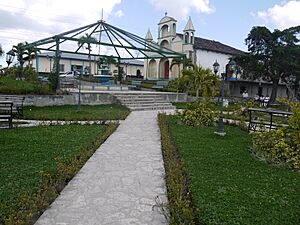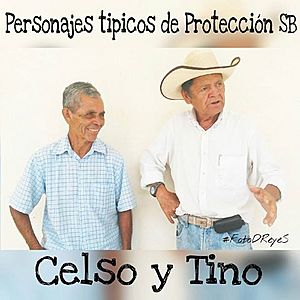Protección facts for kids
Quick facts for kids
Protección
|
|
|---|---|
|
Municipality
|
|

Protección, Santa Barbara, Honduras, Entrance to Town
|
|
| Country | |
| Department | Santa Bárbara |
| Municipality | Protección |
| Founded, El Ocotal | 1880 |
| Renamed Protección | 1883 |
| Municipality | 15 May 1927 |
| Government | |
| • Type | Democratic Municipality |
| Area | |
| • Land | 261.6 km2 (101.0 sq mi) |
| Elevation | 906 m (2,972 ft) |
| Population
(2015)
|
|
| • Total | 16,799 |
| Time zone | UTC-6 (Central America) |
| Climate | Aw |
Protección is a town and a municipality in the Santa Bárbara region of Honduras. It is a place where many people live and work.
Contents
A Look at Protección's Past
Protección started in 1880. Back then, it was called El Ocotal. This name came from the many pine trees in the area. The first people to settle here were herders. They came from Santiago and San Juan Posta to let their animals graze.
At first, they built simple grass huts. But since they had to travel far, they decided to build more lasting homes. These homes slowly formed a new settlement.
How Protección Got Its Name
The village grew quickly. In 1883, people met to choose a new name and make their community official. They decided on Protección. This name means "protection." Why? Because traders often passed through. They found the community was a safe place to rest and feed their animals. So, they called it "protección." The people liked this name. Another idea is that the community felt protected by good fortune.
After the name change, Protección grew even faster. People moved here from other parts of Honduras, and even from Guatemala and El Salvador.
Early Education and Becoming a Municipality
In 1890, the first school opened. It was in a house built by Florencio Martinez. He was also the first teacher in Protección.
In 1898, the land was officially called "communal land." This means it belonged to the community. By 1910, the village leaders wanted Protección to become a municipality. This would give it more official power. After many efforts, Protección officially became a municipality on May 15, 1927. It included several nearby villages like Las Vueltas and La Reina. The founding fathers, like Florencio Martínez, worked hard for the town's growth.
Where is Protección?
Protección covers an area of about 151.6 square kilometers (58.5 square miles). It is located in the western part of the Santa Bárbara department in Honduras.
- To the north, it borders the municipality of Macuelizo.
- To the south, it borders Naranjito.
- To the east, it borders San Luís.
- To the west, it borders the department of Copán.
A road connects Protección to Chalmeca, which is about 13.8 kilometers (8.6 miles) away. Chalmeca is on the main highway between San Pedro Sula and El Salvador. This road to Protección is usually good for travel all year. There are also smaller roads, over 61 kilometers (38 miles) long, that connect to communities around Protección. These smaller roads are best used in the dry season. Rain can make them hard to pass in winter.
Protección is a hilly area. The average height above sea level is about 980 meters (3,215 feet).
Who Lives in Protección?
Protección has about 14,272 people living there. About half are boys and men, and half are girls and women. More than half of the people (53.34%) are 18 years old or younger. This means Protección has a very young population! There are about 55 people per square kilometer.
The population is growing, especially from west to east. People live in lower areas among the hills. The municipality is divided into different types of communities:
- 6 barrios (neighborhoods)
- 19 aldeas (villages)
- 19 caseríos (hamlets)
Barrios (Neighborhoods)
The six barrios are the main urban areas of Protección. About 2,912 people live here, which is 20.4% of the municipality's population. These barrios are often called the "town of Protección."
- Barrio Nuevo
- El Calvario
- El Centro
- San Cristobal
- El Edén
- Las Tejeras
Aldeas (Villages)
The 19 aldeas are home to 8,634 people. This is 60.5% of Protección's population.
- Buenos Aires
- El Chile
- Las Delicias
- El Encanto
- La Laguna
- Loma Encerrada
- Las Naranjas
- Nueva Victoria
- Nuevas Delicias
- Nuevo Corralitos
- Nuevo Porvenir
- El Ocote
- Pueblo Nuevo
- La Reina
- La Ruidosa
- El Triunfo
- Las Vueltas
- Zambrano
- El Zarzal
Caseríos (Hamlets)
The 19 caseríos have 2,726 people, making up 19.1% of the population.
- Aldea Nueva
- El Anillal
- Copo Helado
- El Frijolillo
- El Güiscoyol
- El Higal
- Los Letreros
- La Libertad
- Monte la Virgen
- Nueva Angostura
- Nueva Ceibita
- Nuevos Horizontes
- La Posona
- La Presa
- San José
- La Tendida
- Tres Cruces
- Viejo Porvenir
- La Virtud
Demographics: Who are the People?
In 2013, a census showed that most people in Protección (96.73%) are Mestizo. This means they have mixed European and Indigenous heritage. A smaller number are White (2.56%), Black (0.37%), or Indigenous (0.34%).
Culture and Traditions
Like much of Honduras, the people of Protección are mostly mestizo. Their lives often center around farming. They are known for being friendly, social, and welcoming. They share many customs, traditions, and foods typical of Honduras. People often use nicknames for each other, like "Celso Caspa" or "Tino Plato."
Celebrations and Holidays
Most people in Protección are Roman Catholic, but more and more are becoming Evangelicals. They celebrate Christian holidays like Christmas (La Navidad) and the week before Easter, called Semana Santa.
- Christmas Eve (Nochebuena): Families and friends have a late dinner and light fireworks at midnight.
- Holy Week: There is a procession. Most businesses close on Thursday and Friday, which are national holidays.
Other important celebrations include:
- Patron Saint Festival: This is for San Isidro, the town's patron saint. It's celebrated on May 1st, even though the saint's actual day is May 15th.
- Independence Day: On September 15th, they celebrate Honduras's independence from Spain.
These festivals often include parades, beauty contests, music, food, dancing, live bands, and fireworks.
Traditional Foods
Protección has many delicious traditional foods. Many of them use corn!
- Tamales: A dish made from corn dough, often filled with meat and wrapped in a leaf.
- Travelers' Tamales (ticucos): A special type of tamale.
- Sweet Bread (marquezote): A tasty dessert.
- Cornbread (pan de maiz): Bread made from corn.
- Caramel Milk (dulce en leche): A sweet milk dessert.
- Tripe Soup (sopa de mondongo): A hearty soup.
- Free-Range Chicken Soup (sopa de gallina criolla): Chicken soup made with local chickens.
- Sweetened Stewed Squash (ayote en dulce): A sweet squash dish.
- Corn Tamales (montucas): Made with fresh, green corn.
- Corn Tortas (riguas de atole): Often made with freshly harvested corn.
- Sweet Corn Drink (atol de elote): A warm, sweet drink made from corn.
- Honduran Red Beans (frijoles): A staple food.
- Corn Tortillas (tortilla de maíz): Flatbreads made from corn.
- Fried Cassava (yuca frita): Fried root vegetable.
What is the Economy Like?
The economy in Protección is mostly based on farming.
- Coffee: About 30% of farming is growing coffee to sell.
- Corn and Beans: About 65% is growing corn and beans for families to eat.
- Livestock: Raising cattle is also done on a smaller scale.
Some communities also grow bananas, pineapples, and vegetables. Families sometimes grow extra corn and beans to sell in town. Buyers also drive to villages to buy sacks of grains and coffee, especially during harvest time. Most of the corn and beans (85%) are eaten by the people who grow them. Only about 15% are sold outside the community.
Besides farming, there are small businesses and services. These include carpentry, construction, metal shops, tailors, barbers, and small stores.
In 2012, about 70% of the people were old enough to work. Many people work as homemakers, farmers, laborers, shopkeepers, maids, construction workers, and teachers. Women often help with farm tasks, especially picking coffee. They also earn money by raising chickens, selling eggs, sewing, and running small businesses or eateries.
Climate in Protección
Protección has a mild climate. The average temperature is about 20°C (68°F). The area gets about 1300 millimeters (51 inches) of rain each year.
Honduras has two main seasons:
- Rainy Season (Winter): This is from June to November. Most of Protección's rain falls during this time.
- Dry Season (Summer): This is from late January through May.
Water Resources
Protección is part of a project to protect water sources. Important water sources for the town include La Angostura, Cerro Redondo, Copo Helado, and Las Moras. These areas collect water that flows into major rivers like the Jicatuyo, Chamelecón, and Ulúa. The only river that flows through Protección itself is the Río Blanco.
Forest Resources
The area around Protección is covered with pine forests. Different types of pine trees grow at different heights. For example, Pinus caribaea is common at lower elevations, while Pinus maximinoi grows higher up, above 1300 meters (4,265 feet).
Underneath the tall pine trees, you can find smaller plants like oaks, grasses, and ferns. Sadly, there has been a lot of deforestation. This happens when people cut down trees to find land for their families or for farming. Traditional farming methods, like "slash and burn," also contribute to this problem. Clearing land for cattle and coffee farms also leads to fewer trees. In recent years, new types of coffee plants that don't need shade have also caused more trees to be cut down in Central America.
Images for kids
See also
 In Spanish: Protección (Honduras) para niños
In Spanish: Protección (Honduras) para niños












